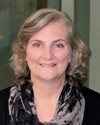
In her role as Administrative Manager, Scientific Program, Judy DeAcetis manages planning of the Annual Meeting program and supports the Board. She joined ASTMH in February 1994. Ms. DeAcetis began her career in nonprofit association management after graduating from the University of Illinois at Urbana-Champaign. Ms. DeAcetis has served on the staff of professional societies such as the International Society for Traumatic Stress Studies, the International Society for Stem Cell Research and the Academy for Eating Disorders.
What are the biggest changes you’ve seen at ASTMH in the last 30 years?
I was very early in my career when I joined the staff of ASTMH, so in a way, I feel like I’ve grown up with the Society. I attended my first Annual Meeting in Cincinnati in 1994 and since that time, the Annual Meeting has grown four-fold. Back then, abstracts were submitted by postal mail on floppy disks and we logged each submission by hand. When I first started with ASTMH, the Annual Meeting featured a total of 43 sessions. Nowadays, the meeting features nearly 180 sessions. With respect to meeting technology, I can remember when teams of local volunteers managed the Speaker Ready Room and ran through the hallways delivering carousels of 35mm slides to meeting rooms. Today, our Speaker Ready Room is staffed by IT professionals and it takes a full AV crew to manage the audio-visual logistics of the meeting. Another big change I’ve witnessed is the increase in fellowship and funding opportunities. For example, in the 1990s, the Ben Kean Travel Fellowship was in its infancy and awarded four fellowships its inaugural year. Since then, ASTMH has awarded over 350 Kean Fellowships.
What do you find most rewarding about your work?
It is very fulfilling to see the all the elements of the Society come together at the Annual Meeting. Every area of ASTMH is represented at the conference, from awards to fellowships to subgroups to committees, and everything in between. Each October/November, 12 months of work by our Board members and volunteers culminates at the Annual Meeting. It is a privilege to support the wonderful work of our members toward improving the lives of people around the world. I feel very fortunate to work with such kind, committed volunteers.
What are the keys to a successful scientific program?
The keys to the Society’s successful scientific program are content and delivery. Our Scientific Program Committee is committed to providing multi-disciplinary content for all of the constituency groups that are part of the Society’s “big tent.” We have 20 working groups on our Program Committee that organize sessions for their particular topic area. This content is delivered in a variety of formats, e.g., Plenary Sessions, Symposium Sessions, Scientific Sessions featuring oral abstract presentations and Poster Sessions. While Plenary Sessions are a more formal setting, the other session formats provide an environment where presenters and attendees can interact via Q&A and group discussion. Over the years, the scientific program has been supplemented by career development sessions such as Career Chats and Speed-Networking, as well as instructional sessions such as Meet the Professors and Ponder-to-Probe, proving there is something for everyone at the ASTMH Annual Meeting.